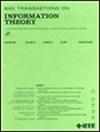次指数随机槽选择隐蔽容量的界
IF 2.9
3区 计算机科学
Q3 COMPUTER SCIENCE, INFORMATION SYSTEMS
引用次数: 0
摘要
我们考虑了二进制输入离散无记忆信道(DMCs)和加性高斯白噪声信道(AWGN)上随机时隙选择的隐蔽通信问题,其中发射器试图与合法接收器可靠地通信,同时保持相对于(w.r.t)窃听者的隐蔽性。隐蔽性是指窃听者无法区分信息的传输和通信的缺失,以固定信道输入的传输为模型。随机时隙选择是指在预定的时隙数量中均匀随机选择一个已知边界的时隙内发送码字的能力。我们的主要贡献是开发了该模型中通信的信息论极限的边界,称为隐蔽容量,当时隙的数量随码字长度呈次指数增长时。隐蔽容量的上界和下界在一个与信道无关的乘因子$\sqrt{2}$内。这一结果部分填补了没有随机插槽选择的隐蔽容量和在码字长度的指数槽数中随机选择的隐蔽容量之间的表征空白。我们的关键技术贡献包括:1)在我们的可实现性证明中,描述随机槽选择对覆盖性约束影响的相对熵的紧密上界;2)仔细的反向分析,以表征码字的最大允许权值或功率,以满足隐蔽性约束。我们的研究结果表明,与没有随机插槽选择的情况不同,在随机插槽选择的情况下,隐蔽度量的选择不会改变隐蔽容量。本文章由计算机程序翻译,如有差异,请以英文原文为准。
Bounds on Covert Capacity With Sub-Exponential Random Slot Selection
We consider the problem of covert communication with random slot selection over binary-input Discrete Memoryless Channels (DMCs) and Additive White Gaussian Noise (AWGN) channels, in which a transmitter attempts to reliably communicate with a legitimate receiver while simultaneously maintaining covertness with respect to (w.r.t.) an eavesdropper. Covertness refers to the inability of the eavesdropper to distinguish the transmission of a message from the absence of communication, modeled by the transmission of a fixed channel input. Random slot selection refers to the transmitter’s ability to send a codeword in a time slot with known boundaries selected uniformly at random among a predetermined number of slots. Our main contribution is to develop bounds for the information-theoretic limit of communication in this model, called the covert capacity, when the number of time slots scales sub-exponentially with the codeword length. Our upper and lower bounds for the covert capacity are within a multiplicative factor of $\sqrt {2}$ independent of the channel. This result partially fills a characterization gap between the covert capacity without random slot selection and the covert capacity with random selection among an exponential number of slots in the codeword length. Our key technical contributions consist of 1) a tight upper bound for the relative entropy characterizing the effect of random slot selection on the covertness constraint in our achievability proof; 2) a careful converse analysis to characterize the maximum allowable weight or power of codewords to meet the covertness constraint. Our results suggest that, unlike the case without random slot selection, the choice of covertness metric does not change the covert capacity in the presence of random slot selection.
求助全文
通过发布文献求助,成功后即可免费获取论文全文。
去求助
来源期刊

IEEE Transactions on Information Theory
工程技术-工程:电子与电气
CiteScore
5.70
自引率
20.00%
发文量
514
审稿时长
12 months
期刊介绍:
The IEEE Transactions on Information Theory is a journal that publishes theoretical and experimental papers concerned with the transmission, processing, and utilization of information. The boundaries of acceptable subject matter are intentionally not sharply delimited. Rather, it is hoped that as the focus of research activity changes, a flexible policy will permit this Transactions to follow suit. Current appropriate topics are best reflected by recent Tables of Contents; they are summarized in the titles of editorial areas that appear on the inside front cover.
 求助内容:
求助内容: 应助结果提醒方式:
应助结果提醒方式:


